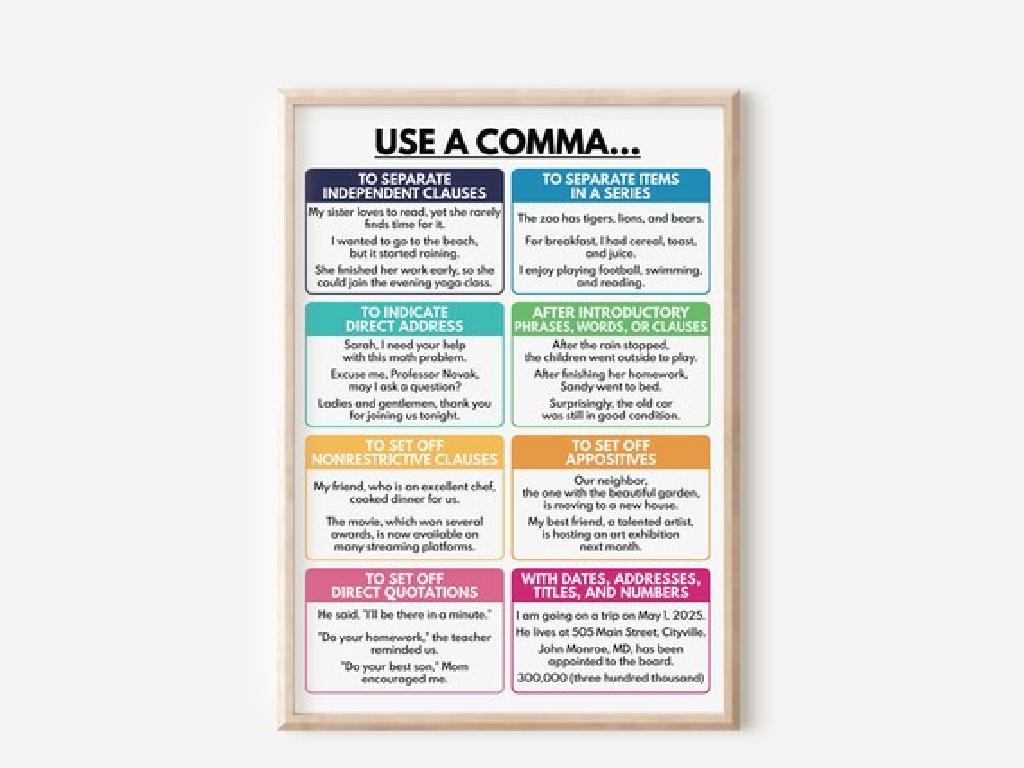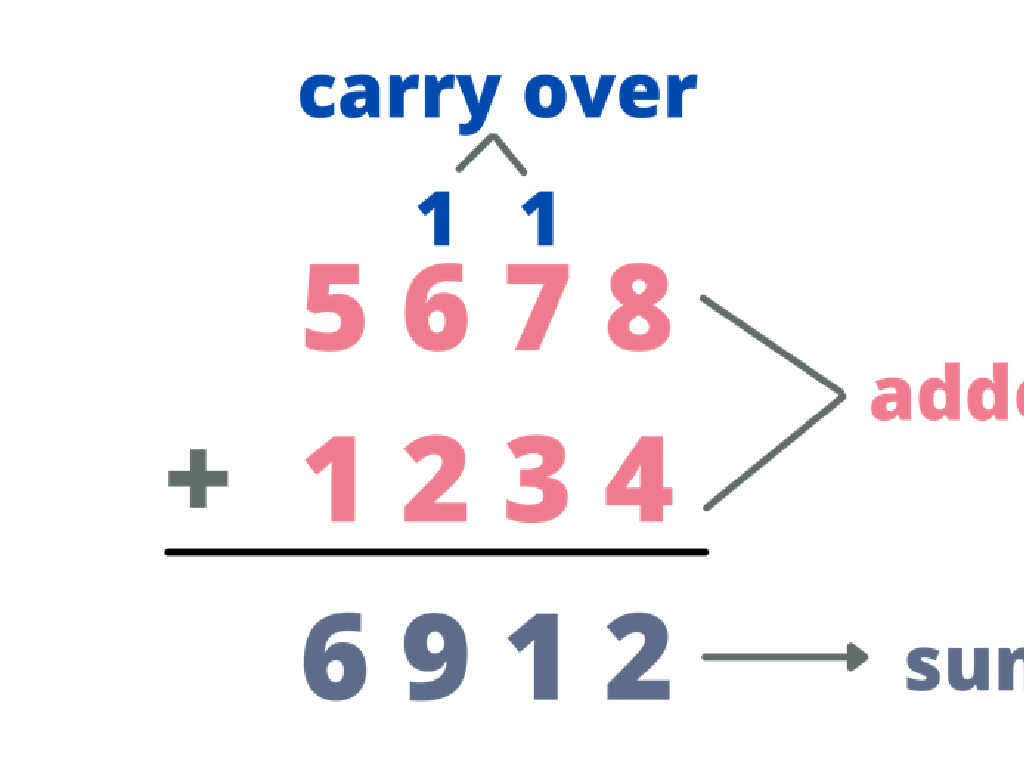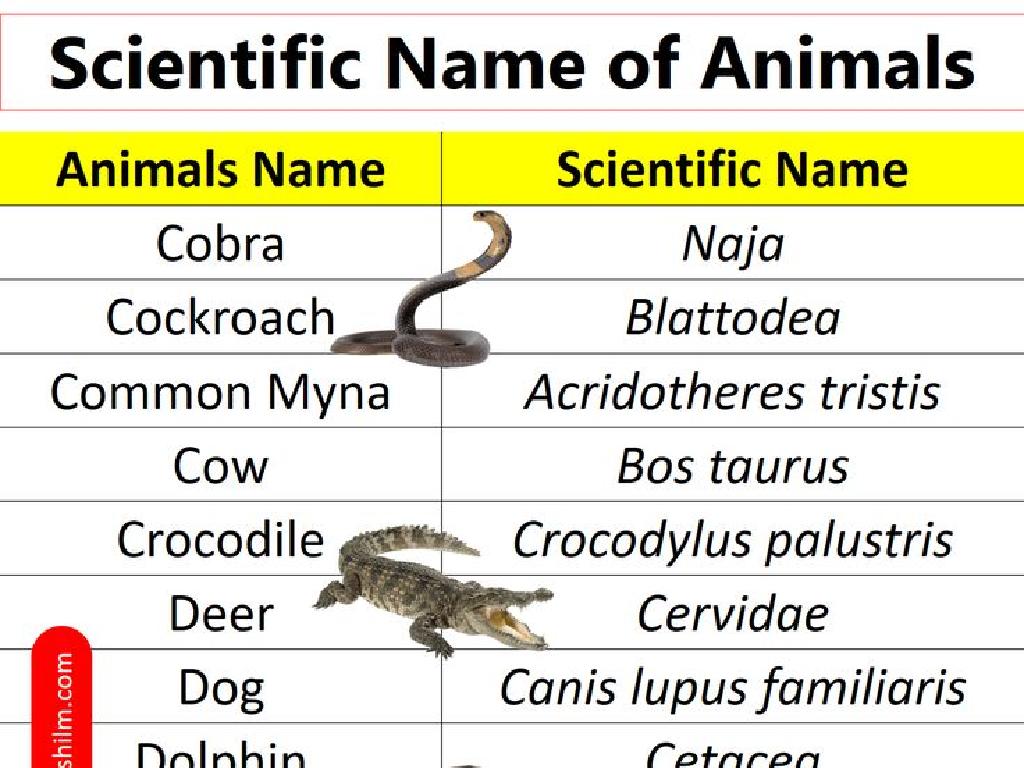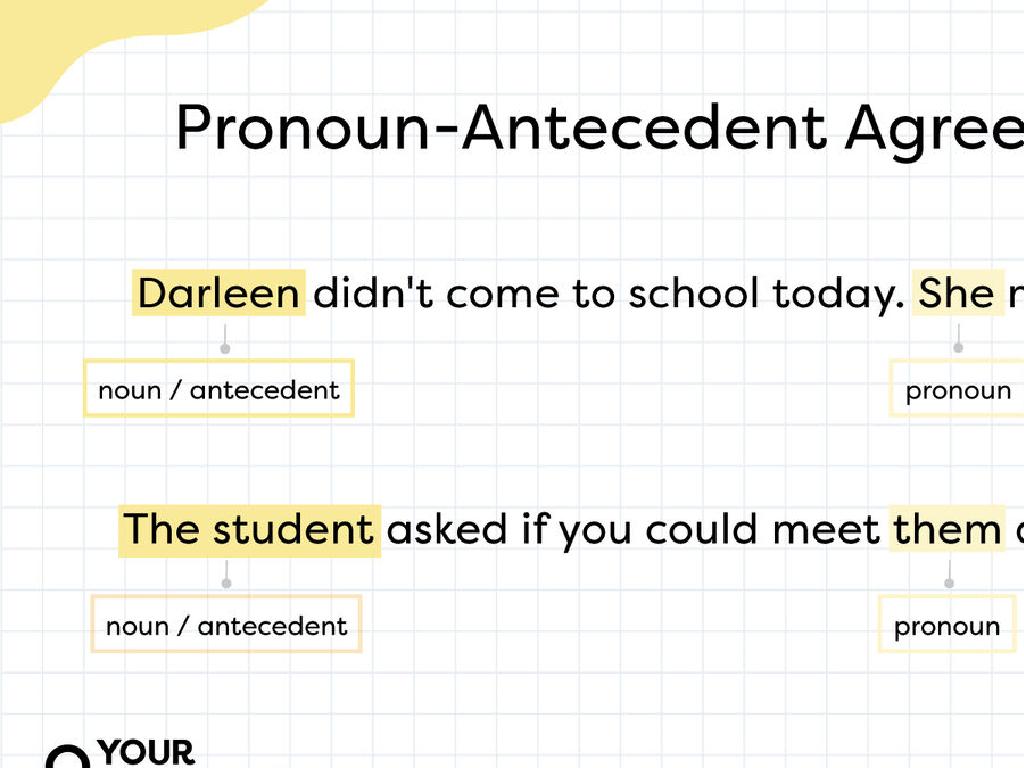Division Facts Up To 12: Select The Missing Numbers
Subject: Math
Grade: Third grade
Topic: Division Fluency Up To 12
Please LOG IN to download the presentation. Access is available to registered users only.
View More Content
Welcome to Division!
– Learn division facts up to 12
– Division is like sharing equally
– If you have 12 cookies and 4 friends, how do you share?
– Practice finding missing numbers
– What number goes into ’12 ÷ __ = 3′?
– Division sentences exploration
– We’ll use examples like ’18 ÷ 6 = __’ to learn
|
This slide introduces third graders to the concept of division as a form of equal sharing. Start by explaining that division is a way to split a whole into equal parts. Use relatable examples, such as sharing cookies among friends, to illustrate this point. Then, guide the students through practice problems where they find the missing number in a division sentence, reinforcing their understanding of division facts up to 12. Encourage students to think of division as the opposite of multiplication. Provide several examples and allow students to work through problems in pairs or groups to foster collaborative learning. The goal is for students to become comfortable with basic division and to recognize patterns in division facts.
Understanding Division
– Division: a basic math operation
– Explains how often a number fits in another
– Example: 12 ÷ 3 equals 4
– If we have 12 apples shared by 3 friends, each gets 4 apples.
– Practice finding missing numbers
– Use division to solve problems like 12 ÷ ? = 4.
|
This slide introduces the concept of division to third-grade students. Division is one of the fundamental operations in mathematics, and it is used to find out how many times one number is contained within another. The slide provides a basic example of division, showing that if we divide 12 by 3, we get 4. This can be visualized as dividing 12 apples evenly among 3 friends, where each friend would receive 4 apples. Encourage the students to think of division as a way of sharing or grouping equally. The last point on the slide prompts students to practice division by finding missing numbers in equations, which helps to reinforce their understanding of the concept. In the next class, students can be asked to solve similar problems and share their methods.
Mastering Division Facts Up to 12
– Memorize division facts for speed
– Explore division facts as a class
– We’ll review examples like 24 ÷ 6 = ?
– Multiplication knowledge aids division
– If you know 6 x 4 = 24, then 24 ÷ 6 = 4!
– Practice makes perfect
– Keep practicing with different numbers!
|
This slide is aimed at reinforcing the importance of memorizing division facts to enhance problem-solving speed. Engage the class by reviewing division facts together, highlighting how knowing multiplication tables can assist in understanding division. Emphasize the reciprocal relationship between multiplication and division. Encourage students to practice regularly by providing worksheets and interactive activities that cover a range of numbers. Remind them that consistent practice is key to mastering division facts up to 12.
Finding Missing Numbers in Division
– Understanding division results
– Relating multiplication to division
– If 4 x ? = 12, what is the missing number?
– Finding the missing divisor
– The missing number in multiplication is the divisor in division.
– Practice with 12 ÷ 4
– Let’s solve 12 ÷ 4 to find the missing number.
|
This slide is aimed at helping third-grade students understand how to find missing numbers in division by relating it to multiplication. Start by explaining that sometimes we know the result of a division problem, but we need to find one of the numbers we divided. Show how multiplication and division are related and how this relationship can help us find the missing number. For example, if we know that 4 times a certain number equals 12, we can find the missing number by solving 12 divided by 4. Encourage students to use this method to find missing divisors in division sentences. Provide additional examples like 9 ÷ ? = 3 and 8 x ? = 32 for practice.
Let’s Practice Division Together!
– Solve the division sentence
– Find the missing number
– Example: 12 ÷ ? = 4
– What number should replace the question mark?
– Correct! The missing number is 3
– 12 divided by 3 equals 4, so ? is 3
|
This slide is an interactive class activity designed to help students practice division facts up to 12. Present a division sentence with a missing number and guide the students to find the missing number by thinking about what number, when divided into 12, results in 4. Reinforce the concept that division is finding out how many times a number is contained within another number. Encourage students to use their multiplication facts to find the answer, as knowing that 3 times 4 equals 12 can help them see that 12 divided by 3 equals 4. Prepare to walk through several examples with the class, and have additional problems ready for students to solve independently or in small groups.
Your Turn to Try: Division Detective
– Find missing numbers in divisions
– Use division facts up to 12
– Recall: 6 ÷ 2 = ?, 12 ÷ 3 = ?
– Multiplication checks your answers
– Example: If 4 x ? = 12, then 12 ÷ 4 = ?
– Practice makes perfect
|
This slide is an interactive activity for students to apply their knowledge of division facts up to 12. Encourage them to solve for the missing numbers in given division sentences. Remind them that knowing their division facts is key and that they can use multiplication to verify their answers. For instance, if they are unsure about 12 ÷ 4, they can think about what number multiplied by 4 gives 12. This reinforces the concept of inverse operations. Have several examples ready for students who finish early or need additional practice, and consider pairing students to promote peer learning.
Class Activity: Division Bingo
– Play Division Bingo game
– Solve division problems on card
– Use division facts up to 12 to find answers
– Mark the square with correct answer
– Aim for five in a row to win
|
Division Bingo is a fun and interactive way to help students practice their division facts up to 12. Prepare bingo cards in advance with different division problems, ensuring that the answers are numbers up to 12. During the activity, call out division questions or display them on the board. Students will solve these problems and mark off the corresponding answers on their bingo cards. The first student to get five correct answers in a row (horizontally, vertically, or diagonally) and shout ‘Bingo!’ wins. To cater to different skill levels, consider having a few variations of the game, such as ‘Four Corners Bingo’ or ‘Full Card Bingo’. This will keep all students engaged and provide a comprehensive review of division facts.
Becoming a Division Star!
– Congratulations on learning division facts!
– Practice is key to mastery
– Just like sports or music, math needs practice too
– Keep practicing for perfection
– Try different numbers and division problems every day
– Aim to be a division star!
|
This slide is meant to congratulate the students on their hard work learning division facts up to 12 and to encourage them to continue practicing. Emphasize the importance of regular practice, as it is essential to becoming proficient in division. Encourage them to practice with different numbers to become more comfortable with division problems. Remind them that with consistent practice, they will become division stars. You can suggest that they use flashcards, play math games, or do a few problems each night as homework to keep their skills sharp.






